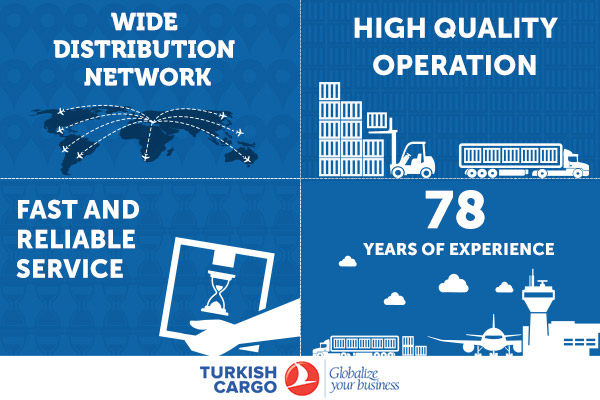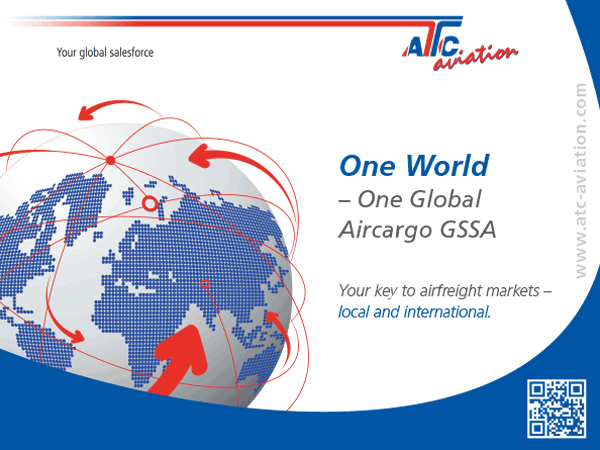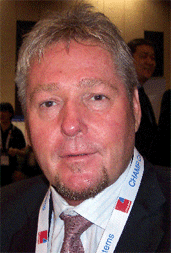 |
 |
 #INTHEAIREVERYWHERE |
| Vol. 15 No. 21 | Monday
March 14, 2016 |
 |
|
As
the chief cargo officer at Delta Airlines Cargo, Vice
President Global Sales and Marketing Ray Curtis is many
things to a host of people around the world. Challenges
of 2016 Perishables As A Foundation Business “Perishable
products are a key component of our business and we
will continue to make investments to support the efficient
and reliable transportation for these products in line
with the needs of our customers. A Matter Of Attention The industry
needs to continue to be innovative and collaborative
to enhance the value proposition of air cargo. What If You Had Superpowers? “Well, I guess the first thing
would be to convert all surface cargo to air freight,”
said Ray Ray. WCS 2016 In Berlin “Participating
in key industry events such as WCS here in Berlin is
paramount not only to the business of Delta, but also
the industry. “It’s about being collaborative. Looking At Life “I would
say the surprise of the world today is the speed of
business and also life in general. |
 |
|
In
a deal that will see Amazon acquire up to 19.9 percent
percent of Air Transport Services Group, Inc., (ATSG),
Amazon Fulfillment Services, Inc.—an affiliate
of Amazon.com, Inc., (as expected)—has agreed
to have ASTG operate an air cargo network via twenty
B767s to serve Amazon customers in the United States.
|
 |
Far From Abandoned Despite closure
as an airfield after THF was made redundant by the building
of BER, space in Tempelhof’s huge sweeping hangar
remains occupied by City of Berlin Police (the Polizei
have been here since 1951) and the radar tower is still
in use by the German Army to monitor flight traffic. Tempelhof Freedom In 2011 city
planners advanced a scheme by former Berlin Mayor Klaus
Wowereit to build apartments on airport land. The plan
was shot down by a referendum that led to a citywide
vote where more than 64 percent cast their ballots telling
politicians and investors to keep their hands off Tempelhof.
Gardens
on Pallets Looking Ahead Because the
people of Berlin took matters into their own hands,
Tempelhof—at least in the near term—will
remain largely as it is.
Heart Of The City It only takes
20 minutes to ride on a bike from the airport to the
Brandenburg Gate and the monumental Reichstag, which
houses the German Parliament. |
If
You Missed Any Of The Previous 3 Issues Of FlyingTypers
Access complete issue by clicking on issue icon or Access specific articles by clicking on article title |
||
 Vol. 15 No. 18 India Buried Under The Weight Where Are We Now? View From A Fish Eye Chuckles For March 2, 2016 Nagpur SEZ MIHAN Over The Moon |
 Vol. 15 No. 19 Will Ocean Containers Add Lift? Dead Heat On A Carousel Chuckles for March 7, 2016 Drone Hits Plane Quick Before It Melts Meanwhile At The FBO |
|
Publisher-Geoffrey
Arend • Managing Editor-Flossie Arend • Film Editor-Ralph Arend • Special Assignments-Sabiha Arend, Emily Arend • Advertising Sales-Judy Miller |
|




 Perishables
Track
Perishables
Track ULD
Track
ULD
Track The best time we ever had in
a ULD was sitting with some Alitalia Cargo workers picketing
Cargo Building 6 at JFK. It started to rain, and after
about 15 minutes the pitter-patter sound of the drops
on the metal above us formed a soporific cloud over
our senses.
The best time we ever had in
a ULD was sitting with some Alitalia Cargo workers picketing
Cargo Building 6 at JFK. It started to rain, and after
about 15 minutes the pitter-patter sound of the drops
on the metal above us formed a soporific cloud over
our senses.




 “We firmly believe that
drones are the future of cargo, no question,”
Svilen told FlyingTypers adding that 20 or
even 10 years from now people would be looking back
and seeing how natural it was for the industry to evolve
in this particular direction.
“We firmly believe that
drones are the future of cargo, no question,”
Svilen told FlyingTypers adding that 20 or
even 10 years from now people would be looking back
and seeing how natural it was for the industry to evolve
in this particular direction. 






